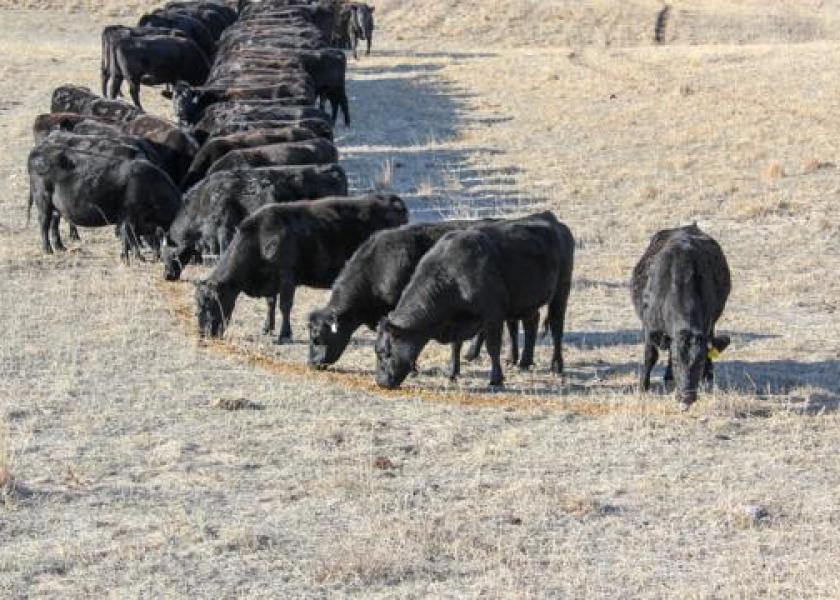Winter feed is one of the greatest costs of cow-calf production. The base ingredient in winter rations is usually standing dormant forage or hay. Heifers, fist-calf heifers, and thin cows that need to gain body condition often need more energy than can be supplied by dormant forage or hay alone. Therefore, many situations require that heifers and cows be fed supplemental protein, energy, or both, depending on the nutrient makeup of the base-forage. Understanding the interaction between starch, fiber, and protein in the cows’ rumen allows producers to determine the most appropriate winter supplement.
Many different types of bacteria and other microorganisms in the rumen convert forage and supplements into nutrients needed to maintain or increase a cow’s body weight. What makes cattle and other ruminant animals so important to the earth’s ecosystem is that a great deal of the energy stored on the planet is stored in the fibrous parts of plants that cannot be used by non-ruminants (humans, birds, and most animals). In addition, it is important to recognize that even cattle and other ruminants can only use the energy stored in the cell walls of plants when the rumen bacteria have enough protein and other nutrients to actively breakdown the fibrous plant parts. Fiber-digesting bacteria, which are important for digesting forage, are relatively slow growing and are easily killed if the rumen becomes acidic. In contrast, starch-digesting bacteria are important to grain-fed ruminants, and reproduce rapidly when starch is available. Starch-digesting bacteria have a much greater tolerance for increased acid in the rumen than do fiber-digesting bacteria.
Changes in diet will change which types of bacteria in the rumen are most plentiful. The types of supplements that cattlemen choose to feed will affect the types of bacteria that dominate the rumen which will have an effect on how well cows can convert the base forage into body weight. Some supplements will increase the digestibility of the base forage, some will not greatly affect the base forage digestibility, and some will actually decrease the ability of cows to convert forage into body weight.
Cattle fed a forage-based diet (grazing or hay) that is deficient in protein (<7% Crude Protein) will benefit by being fed a protein-dense supplement to supply the necessary amount required for reproduction by fiber-digesting bacteria. By increasing the number of fiber-digesting bacteria in the rumen, forage digestibility is increased, the cows’ eat more forage, and the energy yield from the diet is improved.
However, producers should realize that if the base forage has adequate protein content, additional protein will not improve digestibility or energy yield. A typical 1,200-pound cow of average producing ability will need only about 1.7 pounds of crude protein during the middle part of gestation. Feeding a roughage of fair quality (8 to 10% crude protein) during this period should meet both energy and protein requirements, and feeding a protein supplement is not necessary. In contrast, after a cow calves, her requirement for protein increases greatly. A 1,200-pound cow producing 20 pounds of milk requires 3 pounds of crude protein daily and a forage that was adequate in mid-gestation may be very protein deficient for late gestation and early lactation.
Because of the competition that takes place in the rumen between starch-digesting and fiber-digesting bacteria, it is important to limit the amount of grain in the diet of cows grazing standing dormant forage or eating hay. If cows are eating forage of moderate quality (protein content and digestibility), supplementing with too much grain, which is high in starch, will actually decrease the digestibility and available energy from the forage even further. This decrease is due to a shift in the population of rumen bacteria away from a population dominated by fiber-digesters, to a population dominated by starch-digesters. Remember, the starch-digesting bacteria can reproduce rapidly when starch is available, and during rapid growth, starch-digesting bacteria produce increasing levels of lactic acid, which will kill many fiber-digesting bacteria. With fewer fiber-digesting bacteria available, forage digestibility is decreased and energy yield from the forage is reduced.
Because corn and other grains are readily available and often are price-competitive with other sources of energy, producers can use these feeds up to the level where they have a negative effect on fiber digestion. The cut-off for starch supplementation of low-quality forages calculates to be about 0.28% of the cows’ bodyweight for corn dry matter (3.5-4.0 lbs. of corn as-fed for a 1,200-pound cow). For moderate weight gain, a simple diet of forage and less than 3.5-4.0 pounds corn will often be sufficient.
In situations when the base forage has adequate protein, if more weight gain is required than can be met with a starch-based feed such as corn without a negative effect on forage intake and digestibility, producers can choose to use a fiber-based feed that has higher energy content than the base forage. Many by-product feeds provide energy in the form of highly digestible fiber; because the energy is in the same form as that in the forage, high levels can be fed without harming the fiber-digesting bacteria in the rumen or decreasing forage digestibility. By-product feeds that provide energy in the form of highly digestible fiber include: corn gluten feed, distillers grains, soybean hulls, and wheat middlings.
Source: Drovers, Bob Larson DVM November 9, 2022
Photo: Walz








